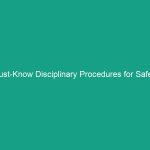Introduction
In today’s work Environment, ensuring the health and Safety of employees is more important than ever. The concept of Health, Safety, and Environment (HSE) encompasses various strategies and practices aimed at protecting workers from Hazards and promoting a safe workplace. Among the numerous threats to employee health, work-related musculoskeletal disorders (MSDs) stand out due to their prevalence and impact. Managing work-related musculoskeletal disorders (MSDs) is crucial not only for the well-being of employees but also for the overall productivity of organizations. In this guide, we will explore the significance of MSDS, the necessary regulatory frameworks, best practices for Prevention, real-world case studies, and the challenges faced in managing these disorders.
The Importance of Understanding MSDs
Musculoskeletal disorders are injuries or disorders that affect the human body’s movement or musculoskeletal system. They can include conditions such as back pain, carpal tunnel syndrome, and tendonitis. Understanding these disorders is essential for several reasons:
- Prevalence: MSDs are among the most common workplace injuries, affecting millions of workers globally.
- Financial Impact: The cost of MSDs to employers can be substantial, affecting healthcare costs, worker productivity, and insurance premiums.
- Legal Obligations: Employers have a legal responsibility to provide a safe working environment, which includes addressing potential MSD risks.
Through effective management of work-related musculoskeletal disorders (MSDs), organizations can enhance employee well-being, reduce costs, and comply with legal requirements.
Regulatory Frameworks Surrounding MSDs
Regulatory bodies around the world have established guidelines and Standards to help organizations manage work-related musculoskeletal disorders (MSDs). Understanding these frameworks is crucial for compliance and effective management.
International Standards
Organizations such as the World Health Organization (WHO) and the International Labour Organization (ILO) have developed guidelines that outline Best Practices for preventing and managing MSDs. These guidelines emphasize the need for:
- Risk Assessment: Conducting thorough evaluations of workplace conditions to identify potential Hazards.
- Employee Training: Providing training on safe work practices and ergonomics to employees.
- Continuous Improvement: Regularly reviewing and updating Safety protocols based on new findings and technologies.
National Regulations
In addition to international guidelines, many countries have specific regulations aimed at reducing the incidence of MSDs. For example, the Occupational Safety and Health Administration (OSHA) in the United States has established standards that require employers to implement measures to minimize ergonomic hazards. Similarly, the Health and Safety Executive (HSE) in the UK provides resources and advice on managing work-related musculoskeletal disorders (MSDs).
Key Components of National Regulations
National regulations typically include the following components:
- Employer Responsibilities: Employers are required to identify risks, implement solutions, and maintain records of incidents.
- Employee Rights: Workers have the right to a safe working environment and to report unsafe conditions without fear of retaliation.
- Reporting Requirements: Many regulations require employers to report MSD incidents to relevant authorities.
Best Practices for Managing Work-Related Musculoskeletal Disorders (MSDs)
Implementing Best Practices is vital for effectively managing work-related musculoskeletal disorders (MSDs). These practices not only help in reducing the incidence of MSDs but also promote a culture of safety within the organization.
Ergonomic Assessments
One of the cornerstone practices in managing MSDs is conducting comprehensive ergonomic assessments. This process involves evaluating workstations, equipment, and workflows to identify potential risk factors. Ergonomists or trained professionals can analyze:
- Posture: Ensuring that employees maintain a neutral position while performing tasks.
- Repetitive Motion: Identifying tasks that require repetitive movements and suggesting alternatives.
- Workstation Design: Adjusting desks, chairs, and tools to fit the employee’s body and work requirements.
Training and Awareness Programs
Training is an essential component of any strategy aimed at managing work-related musculoskeletal disorders (MSDs). Employees should be educated on:
- Proper Lifting Techniques: Demonstrating safe methods for lifting and carrying objects to reduce strain.
- Breaks and Stretching: Encouraging regular breaks and stretching exercises to alleviate muscle tension.
- Ergonomic Principles: Teaching employees how to set up their workstations ergonomically.
Furthermore, creating awareness about the signs and symptoms of MSDs can empower employees to seek help early and prevent worsening conditions.
Implementation of Technology
Advancements in technology provide an array of tools that can assist in managing musculoskeletal disorders. Some innovative solutions include:
- Ergonomic Tools: The use of adjustable desks and chairs, ergonomic keyboards, and specialized tools can significantly reduce strain.
- Wearable Technology: Devices that monitor posture and movements can provide real-time feedback to employees.
- Virtual Ergonomics: Software that simulates work environments and provides recommendations for improvement.
Integrating these technologies into the workplace not only enhances safety but also boosts productivity.
Creating a Supportive Work Culture
Promoting a culture of safety and health within the workplace is essential. Organizations should foster an environment where:
- Open Communication: Employees feel comfortable discussing concerns related to MSDs without fear of judgement.
- Management Support: Leadership actively participates in and supports health initiatives.
- Employee Engagement: Workers are encouraged to participate in safety committees and contribute to health initiatives.
By creating a supportive work culture, employees are more likely to adhere to safety practices and report potential issues before they escalate.
Challenges in Managing Work-Related Musculoskeletal Disorders (MSDs)
Despite the best efforts, several challenges can hinder the effective management of work-related musculoskeletal disorders (MSDs). Understanding these challenges is crucial for developing strategies to overcome them.
Underreporting of MSDs
One significant challenge is the underreporting of MSDs. Employees may hesitate to report their injuries due to fear of repercussions, lack of awareness, or belief that the issue is minor. This underreporting can lead to:
- Inaccurate Data: Organizations may not have a clear understanding of the true extent of MSD-related issues.
- Delayed Interventions: Without accurate reporting, timely interventions may not be implemented, exacerbating conditions.
Encouraging a culture of transparency and providing clear reporting mechanisms can help mitigate this challenge.
Balancing Productivity and Safety
Another challenge is the balancing act between productivity and safety. Organizations often face pressure to meet production deadlines, which can lead to compromised safety practices. To navigate this challenge, organizations should:
- Prioritize Safety: Emphasizing that safety is non-negotiable, even in high-pressure situations.
- Integrate Safety into Productivity Goals: Setting safety performance metrics alongside productivity targets.
By integrating safety into the fabric of the organization’s culture, both productivity and employee well-being can be achieved.
Resource Limitations
Limited resources can pose a significant barrier to effectively managing work-related musculoskeletal disorders (MSDs). Many organizations, especially small businesses, may lack the financial and human resources necessary to implement comprehensive safety programs. Potential solutions include:
- Leveraging Community Resources: Utilizing local health and safety organizations for training and resources.
- Seeking Grants: Applying for grants or funding opportunities aimed at Workplace Safety.
These strategies can help organizations maximize their resources and effectively manage MSDs.
Future Trends in Managing Work-Related Musculoskeletal Disorders (MSDs)
The landscape of managing work-related musculoskeletal disorders (MSDs) is ever-evolving. Staying informed about future trends can help organizations adapt and enhance their safety protocols.
Increased Focus on Mental Health
There is a growing recognition of the connection between mental health and physical well-being. Stress and mental fatigue can exacerbate musculoskeletal issues. As organizations increasingly prioritize mental health, strategies may include:
- Stress Management Programs: Offering workshops and resources to help employees manage stress effectively.
- Mindfulness Practices: Implementing mindfulness training to promote relaxation and focus.
By addressing mental health, organizations can contribute to reducing the incidence of MSDs.
Emerging Technology in Workplace Safety
Technology will continue to play a pivotal role in managing MSDs. Future trends may include:
- Artificial Intelligence: AI-driven data analysis to identify patterns and risk factors related to MSDs.
- Virtual Reality Training: Utilizing virtual reality simulations for training employees in ergonomic practices.
These advancements will enhance the effectiveness of safety programs and foster a proactive approach to MSD management.
Collaboration with Health Professionals
Organizations are increasingly recognizing the importance of collaborating with health professionals to develop comprehensive MSD management strategies. This collaboration can lead to:
- Customized Solutions: Tailoring safety programs based on the specific needs of the workforce.
- Ongoing Support: Providing employees with access to physical therapy, counseling, and other health resources.
Such partnerships can significantly enhance the effectiveness of managing work-related musculoskeletal disorders (MSDs).
Conclusion
Managing work-related musculoskeletal disorders (MSDs) is a critical aspect of Workplace Safety that requires a multifaceted approach. By understanding the importance of MSDs, adhering to regulatory frameworks, implementing best practices, and addressing challenges, organizations can create a safer and healthier work environment. As we look to the future, embracing emerging trends and technologies will enhance our ability to manage these disorders effectively. We encourage employers and employees alike to prioritize safety, advocate for open communication, and invest in health initiatives. Together, we can create safer workplaces that promote well-being and productivity for all.


